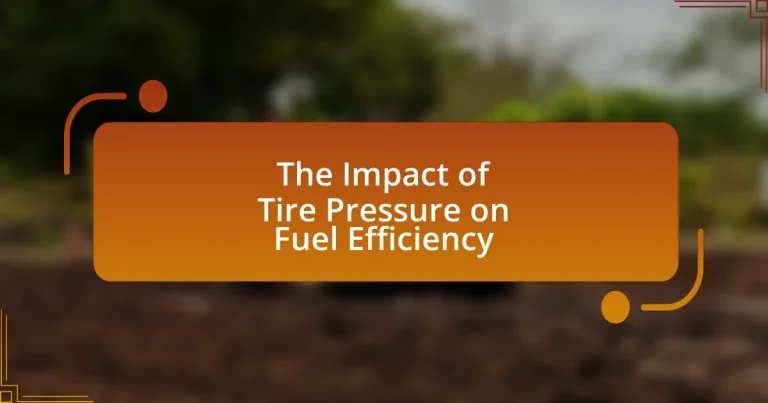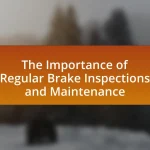Tire pressure is a critical factor influencing fuel efficiency, with under-inflated tires leading to increased rolling resistance and reduced fuel economy. Research indicates that a drop of 1 PSI in tire pressure can decrease fuel efficiency by approximately 0.2%, while maintaining optimal tire pressure can enhance fuel economy by up to 3.3%. Proper tire inflation not only improves fuel consumption but also affects vehicle safety, handling, and overall performance. This article explores the relationship between tire pressure and fuel efficiency, the economic benefits of maintaining proper tire pressure, and practical tips for monitoring and maintaining tire pressure effectively.

What is the Impact of Tire Pressure on Fuel Efficiency?
Tire pressure significantly impacts fuel efficiency, with under-inflated tires leading to increased rolling resistance and reduced fuel economy. Studies indicate that for every 1 PSI drop in tire pressure, fuel efficiency can decrease by approximately 0.2%. This means that maintaining proper tire pressure can enhance fuel efficiency by up to 3% or more, depending on the extent of under-inflation. Properly inflated tires ensure optimal contact with the road, reducing energy loss and improving overall vehicle performance.
How does tire pressure influence fuel consumption?
Tire pressure significantly influences fuel consumption by affecting the rolling resistance of the vehicle. When tire pressure is lower than the recommended level, the increased surface area in contact with the road leads to higher rolling resistance, which requires more energy and fuel to maintain speed. Studies indicate that under-inflated tires can reduce fuel efficiency by approximately 0.2% for every 1 PSI drop in pressure. For example, the U.S. Department of Energy states that maintaining proper tire pressure can improve fuel economy by up to 3.3%. Thus, proper tire inflation is crucial for optimizing fuel consumption and enhancing overall vehicle efficiency.
What is the relationship between tire pressure and rolling resistance?
Tire pressure directly affects rolling resistance, with higher tire pressure resulting in lower rolling resistance. When tires are inflated to the recommended pressure, they maintain their shape better, reducing the energy lost as heat during deformation. Research indicates that for every 1 psi decrease in tire pressure, rolling resistance can increase by approximately 0.3%. This relationship highlights the importance of maintaining proper tire pressure to enhance fuel efficiency and reduce energy consumption.
How does under-inflation affect engine performance?
Under-inflation negatively affects engine performance by increasing rolling resistance, which requires the engine to work harder to maintain speed. This additional effort leads to higher fuel consumption and reduced efficiency. Studies indicate that a drop of just 1 psi in tire pressure can decrease fuel efficiency by approximately 0.2%, demonstrating a direct correlation between tire pressure and engine workload. Consequently, maintaining proper tire inflation is crucial for optimal engine performance and fuel efficiency.
Why is maintaining proper tire pressure important for fuel efficiency?
Maintaining proper tire pressure is crucial for fuel efficiency because under-inflated tires increase rolling resistance, leading to higher fuel consumption. Research indicates that for every 1 PSI drop in tire pressure, fuel efficiency can decrease by approximately 0.2%. This means that properly inflated tires can improve gas mileage by 3% to 4%, significantly reducing fuel costs over time. Additionally, the U.S. Department of Energy states that maintaining optimal tire pressure can enhance vehicle safety and extend tire life, further supporting the importance of proper tire maintenance for overall efficiency.
What are the economic benefits of optimal tire pressure?
Optimal tire pressure leads to significant economic benefits, primarily through improved fuel efficiency. When tires are inflated to the recommended pressure, vehicles can achieve up to a 3% increase in fuel economy, as stated by the U.S. Department of Energy. This translates to savings of approximately $0.11 per gallon of fuel consumed. Additionally, maintaining optimal tire pressure reduces tire wear, extending tire lifespan by up to 25%, which can save drivers hundreds of dollars in replacement costs over time. Furthermore, proper tire pressure enhances vehicle safety, potentially reducing accident-related expenses. Overall, the economic advantages of optimal tire pressure are evident in fuel savings, reduced maintenance costs, and improved safety outcomes.
How does tire pressure affect vehicle safety and handling?
Tire pressure significantly affects vehicle safety and handling by influencing traction, braking distance, and stability. Properly inflated tires ensure optimal contact with the road, enhancing grip and reducing the likelihood of skidding or hydroplaning. According to the National Highway Traffic Safety Administration, under-inflated tires can increase stopping distances by up to 30%, compromising safety. Additionally, correct tire pressure contributes to better vehicle handling, allowing for more responsive steering and improved cornering stability, which is crucial during emergency maneuvers. Conversely, over-inflated tires can lead to reduced traction and increased wear, further impacting safety and handling.
What are the recommended tire pressure levels for different vehicles?
The recommended tire pressure levels vary by vehicle type, typically ranging from 30 to 35 PSI (pounds per square inch) for passenger cars, 35 to 40 PSI for SUVs, and 40 to 45 PSI for light trucks. These specifications are provided by vehicle manufacturers and can usually be found on a sticker inside the driver’s door or in the owner’s manual. Maintaining the correct tire pressure is crucial for optimal fuel efficiency, as under-inflated tires can decrease fuel economy by up to 3% for every 1 PSI drop in pressure.
How can drivers find the correct tire pressure for their vehicles?
Drivers can find the correct tire pressure for their vehicles by checking the vehicle’s owner manual or the tire information placard, typically located on the driver’s side door jamb. These sources provide the manufacturer’s recommended tire pressure, which is crucial for optimal fuel efficiency and safety. According to the National Highway Traffic Safety Administration, maintaining the correct tire pressure can improve fuel economy by up to 3% and enhance tire lifespan.
What factors influence the ideal tire pressure for specific driving conditions?
The ideal tire pressure for specific driving conditions is influenced by factors such as load, temperature, driving speed, and road conditions. Load affects tire pressure because heavier loads require higher pressure to maintain optimal contact with the road, ensuring safety and fuel efficiency. Temperature plays a critical role, as tire pressure decreases in colder conditions and increases in warmer conditions; for instance, a drop of 1 PSI occurs for every 10°F decrease in temperature. Driving speed also impacts tire pressure; higher speeds can lead to increased heat and pressure, necessitating adjustments to avoid blowouts. Lastly, road conditions, such as rough or uneven surfaces, may require different tire pressures to enhance traction and stability. These factors collectively determine the optimal tire pressure needed to maximize fuel efficiency and ensure safe driving.
How can drivers monitor and maintain tire pressure effectively?
Drivers can monitor and maintain tire pressure effectively by using a reliable tire pressure gauge to check the pressure at least once a month and before long trips. Maintaining the recommended tire pressure, typically found on the driver’s side door jamb or in the owner’s manual, ensures optimal fuel efficiency and safety. According to the U.S. Department of Energy, properly inflated tires can improve fuel efficiency by up to 3.3%, while under-inflated tires can decrease fuel economy by 0.4% for every 1 psi drop in pressure. Regularly checking and adjusting tire pressure not only enhances vehicle performance but also extends tire life and improves handling.
What tools are available for checking tire pressure?
The tools available for checking tire pressure include digital tire pressure gauges, analog tire pressure gauges, and tire inflators with built-in pressure gauges. Digital tire pressure gauges provide precise readings and are often easier to read than analog versions, which use a dial to indicate pressure. Tire inflators with built-in gauges allow users to inflate tires while simultaneously checking the pressure, ensuring optimal inflation levels. These tools are essential for maintaining proper tire pressure, which can significantly impact fuel efficiency; for instance, under-inflated tires can reduce fuel economy by up to 3% for every 1 PSI drop in pressure.
How often should tire pressure be checked for optimal fuel efficiency?
Tire pressure should be checked at least once a month for optimal fuel efficiency. Maintaining the correct tire pressure can improve fuel economy by 0.6% to 3% according to the U.S. Department of Energy. Under-inflated tires increase rolling resistance, leading to higher fuel consumption. Regular checks ensure that tires are inflated to the manufacturer’s recommended levels, which is crucial for maximizing efficiency and safety.
What are common misconceptions about tire pressure and fuel efficiency?
Common misconceptions about tire pressure and fuel efficiency include the belief that over-inflating tires improves fuel efficiency and that tire pressure does not significantly affect fuel consumption. In reality, while properly inflated tires can enhance fuel efficiency by reducing rolling resistance, over-inflation can lead to uneven tire wear and decreased traction, potentially compromising safety. Studies indicate that under-inflated tires can reduce fuel efficiency by up to 3% for every 1 PSI drop in pressure, highlighting the importance of maintaining the recommended tire pressure for optimal performance and safety.
Why do some drivers underestimate the importance of tire pressure?
Some drivers underestimate the importance of tire pressure due to a lack of awareness about its direct impact on vehicle performance and safety. Many individuals are unaware that improper tire pressure can lead to decreased fuel efficiency, with studies indicating that under-inflated tires can reduce fuel economy by up to 3% for every 1 PSI drop in pressure. Additionally, drivers often neglect regular tire maintenance, believing that tires are fine as long as they appear visually intact, which further contributes to the underestimation of tire pressure’s significance.
How can misinformation about tire pressure lead to increased fuel costs?
Misinformation about tire pressure can lead to increased fuel costs because incorrect tire inflation affects vehicle fuel efficiency. When tires are under-inflated, rolling resistance increases, causing the engine to work harder and consume more fuel. According to the U.S. Department of Energy, under-inflated tires can decrease fuel efficiency by approximately 0.2% for every 1 psi drop in the average tire pressure. Therefore, if drivers rely on inaccurate information regarding optimal tire pressure, they may not maintain proper inflation, resulting in higher fuel consumption and costs.
What practical tips can help improve fuel efficiency through tire maintenance?
Maintaining proper tire pressure is essential for improving fuel efficiency. Regularly check tire pressure at least once a month and before long trips, as under-inflated tires can decrease fuel economy by up to 3% for every 1 PSI drop in pressure. Additionally, ensure that tires are rotated and aligned according to the vehicle manufacturer’s recommendations, as uneven wear can lead to increased rolling resistance, negatively impacting fuel efficiency. Lastly, inspect tires for damage and replace them when tread depth falls below 2/32 of an inch, as worn tires can also contribute to reduced fuel economy.


